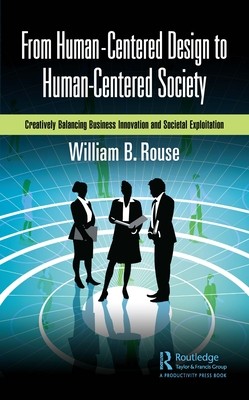
- We will send in 10–14 business days.
- Author: William B Rouse
- Publisher: Productivity Press
- ISBN-10: 1032611731
- ISBN-13: 9781032611730
- Format: 15.2 x 22.9 x 1.1 cm, minkšti viršeliai
- Language: English
- SAVE -10% with code: EXTRA
From Human-Centered Design to Human-Centered Society (e-book) (used book) | bookbook.eu
Reviews
Description
A human-centered society creatively balances investments in sources of innovation, while also governing in a manner that
eventually limits exploitation by originators once innovations have proven their value in the marketplace, broadly defined to include both private and public constituencies.
The desired balance requires society to invest in constituencies to be able to create innovations that provide current and future collective benefits, while also assuring society provides laws, courts, police, and military to protect individual rights to life, liberty, and the pursuit of happiness.
The balance addresses collectivism vs. individualism. Collectivism emphasizes the importance of the community. Individualism, in contrast, is focused on the rights and concerns of each person. Unity and selflessness or altruism are valued traits in collectivist cultures; independence and personal identity are central in individualistic cultures."
Collectivists can tend to become so focused on collective benefits that they ignore sources and opportunities for innovation. Individualists can tend to invest themselves, almost irrationally, in ideas and visions, many of which will fail, but some will transform society. Collectivists need to let individualists exploit their successful ideas. Individualists need to eventually accept the need to provide collective benefits.
This book addresses the inherent tension underlying the pursuit of this balance. It has played a central role in society at least since the Industrial Revolution (1760-1840). Thus, the story of this tension, how it regularly emerges, and how it is repeatedly resolved, for better or worse, is almost a couple of centuries old. Creating a human-centered society can be enabled by creatively enabling this balance. Explicitly recognizing the need for this balance is a key success factor.
This book draws upon extensive experiences within the domains of transportation and defense, computing and communications, Internet and social media, health and wellness, and energy and climate. Balancing innovation and exploitation takes varying forms in these different domains. Nevertheless, the underlying patterns and practices are sufficiently similar to enable important generalizations.
EXTRA 10 % discount with code: EXTRA
The promotion ends in 23d.10:44:57
The discount code is valid when purchasing from 10 €. Discounts do not stack.
- Author: William B Rouse
- Publisher: Productivity Press
- ISBN-10: 1032611731
- ISBN-13: 9781032611730
- Format: 15.2 x 22.9 x 1.1 cm, minkšti viršeliai
- Language: English English
A human-centered society creatively balances investments in sources of innovation, while also governing in a manner that
eventually limits exploitation by originators once innovations have proven their value in the marketplace, broadly defined to include both private and public constituencies.
The desired balance requires society to invest in constituencies to be able to create innovations that provide current and future collective benefits, while also assuring society provides laws, courts, police, and military to protect individual rights to life, liberty, and the pursuit of happiness.
The balance addresses collectivism vs. individualism. Collectivism emphasizes the importance of the community. Individualism, in contrast, is focused on the rights and concerns of each person. Unity and selflessness or altruism are valued traits in collectivist cultures; independence and personal identity are central in individualistic cultures."
Collectivists can tend to become so focused on collective benefits that they ignore sources and opportunities for innovation. Individualists can tend to invest themselves, almost irrationally, in ideas and visions, many of which will fail, but some will transform society. Collectivists need to let individualists exploit their successful ideas. Individualists need to eventually accept the need to provide collective benefits.
This book addresses the inherent tension underlying the pursuit of this balance. It has played a central role in society at least since the Industrial Revolution (1760-1840). Thus, the story of this tension, how it regularly emerges, and how it is repeatedly resolved, for better or worse, is almost a couple of centuries old. Creating a human-centered society can be enabled by creatively enabling this balance. Explicitly recognizing the need for this balance is a key success factor.
This book draws upon extensive experiences within the domains of transportation and defense, computing and communications, Internet and social media, health and wellness, and energy and climate. Balancing innovation and exploitation takes varying forms in these different domains. Nevertheless, the underlying patterns and practices are sufficiently similar to enable important generalizations.


Reviews